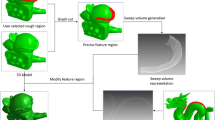Abstract
Many systems support the design of two-dimensional (2D) regions and three-dimensional (3D) volumes by sweeping a generator contour over a spine. Well-established and widely used rendering systems accept high-level boundary descriptions of regions and solids but not in the contour-spine form. Hence the swept object design specification must be such as to lend itself to efficient evaluation of a compact and high-level boundary description. In this paper, we identify a sufficiently general class of swept objects and classify the sweep rules. We also present computational methods for directly evaluating the boundary representation which implicitly simulate the sweep process. The boundary is generated as a set of piecewise curves/surfaces in a compact form suitable for direct input to rendering systems like Post-Script(R) in 2D and Renderman(R) in 3D.
Similar content being viewed by others
References
Adobe Systems Incorporated (1985) Postcript language: reference manual. Addison-Wesley, Reading
Ahn JW, Kim MS, Lim SB (1992) Approximate general sweep boundary of 2 D object. In: Kunii TL (ed) Visual computing. Springer, Tokyo, pp 547–566
Boissonnat JD (1988) Shape reconstruction from planar cross sections. Compute Vision Graph Image Processing 41(1):1–28
Chiyokura H (1988) Solid modelling with designbase: theory and implementation. Addison-Wesley, Wokingham
Elber G, Cohen E (1991) Error bound variable distance offset operator for free form curves and surfaces. Int J Comput Geometry Appl 1(1):67–78
Farouki RT (1986) The approximation of non-degenerate offset surfaces. Comput Aided Geometric Design 3(1):15–43
Ghosh PK, Mudur SP (1984) The brush-trajectory approach to figure specification: some algebraic solutions. ACM Trans Comput Graph 3:110–134
Hoschek J, Wissel N (1988) Optimal approximate conversion of spline curves and spline approximation of offset curves. Comput Aided Design 20(8):475–483
Knuth D (1979) Mathematical typography. Bull Am Math Soc 1:337–372
Magnenat-Thalmann N, Thalmann D (1988) Construction and animation of a synthetic actress. Eurographics 88:61–79
Marr D (1982) Vision: computational investigation into human representation and processing of visual information. Freeman, San Francisco
Parida L (1990) Vinyas—user reference manual. NCST Internal Report NCST/GR/TR-8901
Parida L (1993) Vinyas: an interactive calligraphic type design system. Proceedings of International Conference on Computer Graphics (ICCG 93), North-Holland, 1993:355–368
Parida L, Mudur SP (1991) Computational methods for evaluating the boundary of cross sectional designs. NCST Internal Report, NCST/GR/TR-9101
Shinagawa Y, Kunni TL (1991) The homotopy model: a generalized model for smooth surface generation from cross sectional data. The Visual Computer 7:72–86
Upstill S (Pixar) (1990) The Renderman Companion. Addison-Wesley, Reading
Wijk JJ (1984) Ray tracing objects defined by sweeping planar cubic splines. ACM Trans Comput Graph 3:223–237
Woodward CD (1987) Cross-sectional design of B-spline surfaces. Comput Graph 11 (2):193–201
Author information
Authors and Affiliations
Corresponding author
Rights and permissions
About this article
Cite this article
Parida, L., Mudur, S.P. Computational methods for evaluating swept object boundaries. The Visual Computer 10, 266–276 (1994). https://doi.org/10.1007/BF01901583
Issue Date:
DOI: https://doi.org/10.1007/BF01901583




